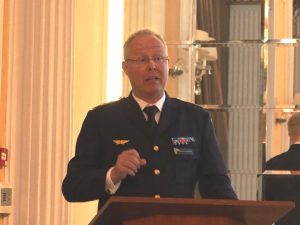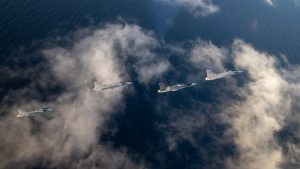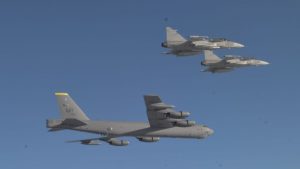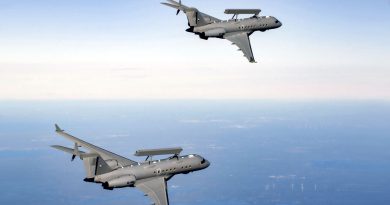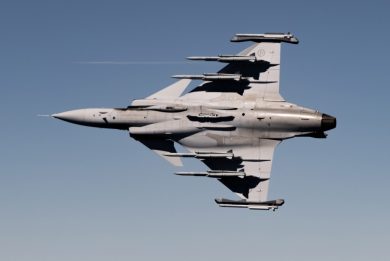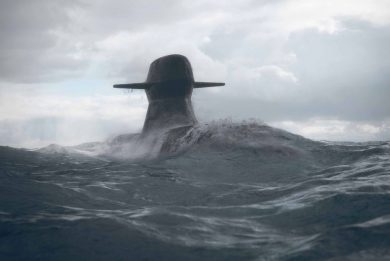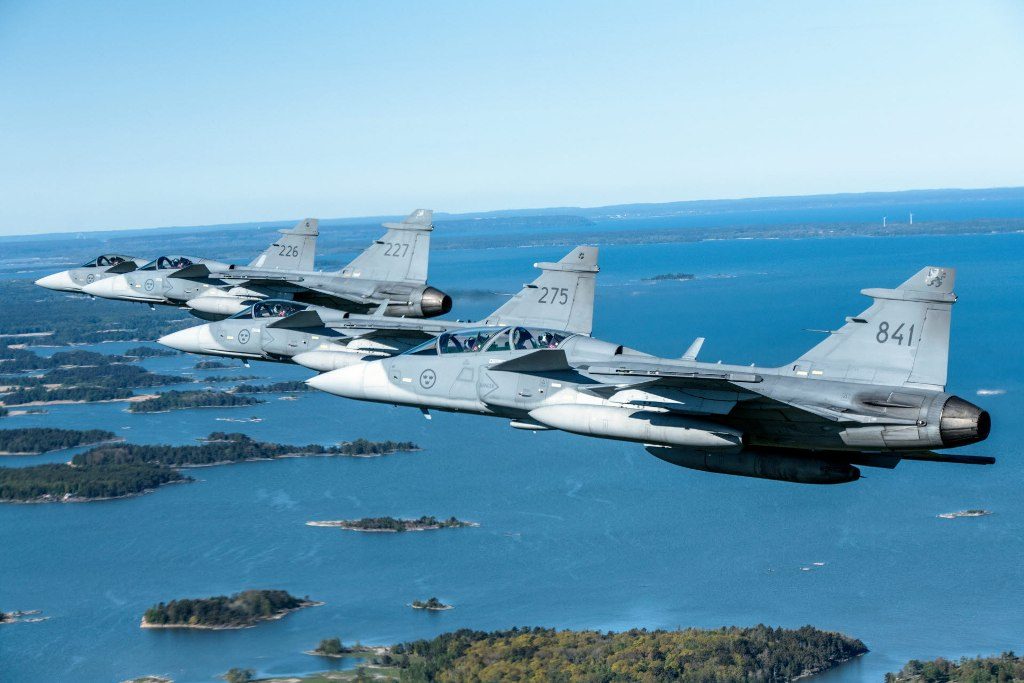
Swedish Air Force: the way ahead
“We like to think that we have proven threat-based capability developments, we continuously observe and analyse the threat environment in our region, and likely in the period of decreasing budgets we kept our intelligence branch intact, and it never took its eyes off Russia,” Major General Carl-Johan Edström, Chief of the Swedish Air Force states in the introductory notes to his briefing before an international audience of aviation journalists, organised by the Swedish Air Force Fan Club at the Royal Air Force Club in London, between the Royal International Air Tattoo and Farnborough International Airshow. A yearly event that takes place before the Farnborough and Le Bourget events, this meeting was cancelled two years in a row due to the pandemics and finally came back on Sunday July 17th in London.
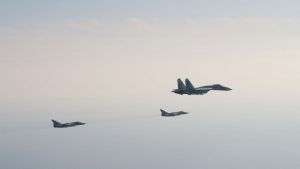
Since February 24th 2022 the European scenario has dramatically changed. EEDR On-Line understood that in fact the number of Swedish air space violations has decreased as most of the Russian Air Force is involved in the conflict with Ukraine, however some of those violation took an unprecedented form. On Wednesday, March 2nd, two four Russian aircraft, two SU 27 and two SU 24 briefly entered Swedish airspace east of the Swedish island of Gotland in the Baltic Sea. “We monitored the situation and our Gripens were ready to intercept them,” Maj.Gen. Edström told us, underlining how this action was quite unprecedented, while dismissing another violation that occurred recently as an “unprofessional mistake”.
It is obvious that the situation has radically changed compared to the past, which brought Sweden, a long lasting neutral country, to apply for NATO membership, something that is de-facto a reality albeit it has still to be officially accepted.
“Our threat analysis forms the base of our operational concept which is based on tactical capabilities development, and hopefully resulting in fielded systems that are able to counter current and future threats, and thereby be relevant at all times,” the Swedish AF Chief added.
Among new capabilities on the enemy side he cited the increased proliferation of long-range precision weapons, with increased range and speed, are a worrying element as they decrease warning time, the improved enemy capability to find, track and target friendly assets, and the use of disrupting technologies such as Artificial Intelligence, hypersonic weapons and swarming drones, are all elements duly taken into account by Sweden in its threat analysis. The massive increase of satellites is another element that worries Maj.Gen. Edström; “this means we have to improve space awareness to keep track of all those sensors in order to exploit movement and deception,” adding however that those new high-tech threats have not taken away more traditional threat such as bombers, strike aircraft, fighter aircraft, Special Forces, naval assets and of course ground troops. All these will be supported by psyops and cyber operations, these starting long before military action.
The inherently defensive posture of Sweden, as well as that of NATO, allow an aggressor to be able to choose time, place, and methods, while Sweden, as well as the West as a whole, will probably remain outnumbered. And Swedish and NATO air assets will definitely be on the enemy priority list in his opening attack.
A strong and balanced Air Force, tactically and technologically superior in the air domain as well as tactically superior on the ground, this is the Swedish recipe to ensure air dominance but this is in fact not attainable, the Chief of the Air Force has to admit. “We would like to be superior in all those aspects, but that would never be the case for such a small force as ours.” As superior quantity is unachievable, keeping the right balance is a must, distributing efforts in all aspects of Air Power. “Technologically speaking we can assume to be on the same level with our adversary,” but superiority must be the aim, while tactical superiority comes from the way assets are used. And as Sweden was not much involved in asymmetric operations, it kept working on peer enemy scenarios rather than relying on air dominance as it was the case for many other nations, and this gives the service Chief the confidence that his Air Force maintains a fighting edge.
But what he stresses the most, underlining that this was neglected by many, is tactics on the ground. Disperse base operations have been a hallmark of the Swedish Air Force since the Cold War era, and those capabilities were maintained and recently event improved. Not only Swedish combat aircraft operate from motorways purposely designed to ensure sufficient straight sections to allow take-off and landing, but also main air bases are build with multiple runways and shelters, which allow constant movement within the base itself to deny the enemy the certainty of targeting the right area. This type of operation must be clear since the design phase of an aircraft, which makes the national industrial capability to fully develop combat aircraft a key element for Air Force operations. Simplicity in maintenance and turn-around is another factor, the service aiming at what is dubbed as “Hangar on Wheels” concept. An interesting slide was shown, depicting the organisation of the service Maintenance Platoon, a 33-strong formation with a 3-man command element and two 15-man sections, each with 8 vehicles and trailers, so capable to split and work in two different locations. Self-sustained, capable to defend itself, the platoon is capable to service a 2-ship formation H24 of a 4-ship one H12, and carry out a 4-ship turnaround in 10-15 minutes time. “We didn’t exploited yet some of the disrupting technologies in this field, so I look forward for further improvements,” the Air Force Chief says underlining that the Ukrainian Air Force protected its assets by moving them from base to base, which shows that the system works.
While this ensures the capability to generate a high number of sorties while reducing vulnerability to enemy attacks, and Air Force remains however based on flying assets.
Starting from combat assets, the Air Force Chief underlines the Swedish way to carry out development. “Our philosophy, together with FMV and Saab, is what we define continuous development, releasing almost yearly software upgrades, with larger upgrades that often also include hardware every 3-4 years,” he explains, the main reason being to maintain an edge over the opponent at all times, this being coupled to an optimised management of available resources. Showing the roadmap for Gripen upgrades, the M21 is bringing to the Gripen E while major decisions are being taken for upgrading the C/D aircraft that includes obsolescence that must be solved while introducing those improvements that will keep the 4th generation aircraft relevant in the coming years, until 2035. The creation of a seventh fighter squadron has been sanctioned, and around 2030 the Swedish Air Force should count on an even mix of around 120 aircraft between Gripen E and C/D. “The Gripen E will be a game-changer, for us and for the northern region, and although it looks similar to the C/D it has a new airframe, new engine, increased weapons payload, new avionics, a new sensor suite , a new radar, a new EW system, so it is in fact a new aircraft,” he says, comparing it to the F-35s and Rafales. The Gripen E was however not designed to be stealth, “and this led us to adopt a different path, which is a highly advanced, capable and integrated electronic warfare system, both active and passive, and this will allow us operating in highly contested air spaces.” Another key element, according to Maj.Gen. Edström , is the avionic systems it separates flying data critical systems from tactical systems and this will simplify upgrades, “and this is from my standpoint as the Chief of the Air Force is probably the most important element looking at the future, especially in this rapidly evolving science and technology world.”
If Gripens were able to quickly intercept the Russian 4-ship formation that was also due to the sensors chain deployed by Sweden. “This is starting to become obsolete,” Maj.Gen. Edström underlines, “so in the coming decade we will review the whole sensors chain, which will be a mix of fixed and mobile sensors, both active and passive. We did not yet made a study on what NATO membership will imply in this area, but it will most likely have an impact on how we must design our sensors chain.” On 30 June the Swedish FMV announced the acquisition for two GlobalEyes, named S106A in Sweden, which will give us the ability to serve not only Air Force needs but also to provide data to Army and Navy, creating an all-domain situational awareness,” he said, adding that he considers these two aircraft as real game-changers. “They will provide intelligence in all domains, increase the coverage of land-based radars, provide extensive pre-warning time, and ensuring an extended on-station time in operation.”
Coming to space, Maj.Gen. Edström depicts the way ahead of Sweden in this field. “We will grow our space capability in four areas: space situational awareness with our own satellites, national launch capability, responsive space capabilities in cooperation with NATO and allies, and space code of conduct.” Space assets will not be relevant only to the Air Force, but to all Armed Forces and even to the civil society, according to the speaker, who also underlined how Swedish industry and academia are at the forefront in many space-related areas, the Esrange Space Center becoming probably in the future the centre of the Swedish space resources ecosystem. “We are investing in Esrange with the aim of developing our own launch capability within a couple of years,” the Air Force Chief states adding that “having recently signed a cooperation agreement with the US Space Command, we are well on track in four out of five of those main areas for space development.”
In his closing remarks Maj.Gen. Edström underlines that Sweden wants to play an active role in the Nordic Dimension, which will play a vital role in the defence of the Alliance northern flank, shifting to the collective defence concept, the four Nordic countries representing a coherent mass of land, half of which bordering Russia. On the other hand NATO expects from NATO the security which is inherent in Article 5, the availability of critical enablers, such as air-to-air refuelling, security of supply, endurance, aligning national plans with NATO plans, and last but not least intelligence sharing.
Among challenges, the first on Maj.Gen. Edström list is personnel. And this brings to pilots’ training. On May 5th 2021 FMV announced the acquisition of seven Grob G 120TP basic trainers. “Originally, when our budget was limited to 1% GDP, we intended do the advanced training on Gripen C/Ds. However in the new situation, with our budget aiming at 2% GDP in 2028 and the need to keep our six operational squadrons as operational as possible, we decided that for 10-15 years advanced training and lead-in fighter training will be done out of Sweden, and we should take a decision in early 2023.” That said, Sweden has already issued an RfI to start looking at possible “in house” solutions for the future. It might look for partners, possibly in the Nordic area.
As for fighters, looking at the Gripen C/D the Air Force Chief intent is to maintain weapons commonalities with the E-model, while among his wishes is to see a new radar installed on the 4th generation fighter in some years. These aircraft should start to be phased out after 2035, Sweden remaining committed to the Tempest programme with the UK and Italy. The Swedish Chief of Defence will release a new Defence Guidance document in November 2022 that will contain the national defence needs post-2025 and at that point more will be known on the replacement of the older Gripens in the late 2030s.
Another cooperation programme is that for the new medium transport aircraft, which will involve France, Germany and Sweden, and which was announced in late June 2022. Maj.Gen. Edström confirmed that the first four C-130H out of the six in service will be replaced with C-130Js. “Their capabilities perfectly fit our needs, and moreover it will allow commonality with our Norwegian and Danish neighbours that already operate this model.” A decision foe the replacement of the two last aircraft has yet to be made.
Coming to helicopters, the H15 (A109) training aircraft will be phased out by 2030, and a study on its replacement is in the final phase. Blackhawks (Hkp. 16s) are to stay well into the 2040s. As for the NH90 (Hkp. 14) Maj.Gen. Edström said that these aircraft “are not delivering, and the antisubmarine role is vital for our Navy.” Therefore Sweden is about to decide what to do, and might well follow the Norwegian path to stop operations with that helicopter.
As for UAVs, currently Sweden is focusing on small airframes and on how to better exploit their capabilities throughout the Armed Forces. Economic and capability issues are being considered, and the Air Force would be glad to get some long range and endurance unmanned assets, but priority is currently been given to manned assets.
A better communications structure level built on an IP-based system that allows sharing classified information among services is considered key, as well as better tactical communications, those being not limited to the Air Force.
A joint problem that soon Maj.Gen. Edström will see from a different standpoint, as he will soon become the Chief of Joint Operations.
Photos courtesy Swedish Air Force and P. Valpolini

